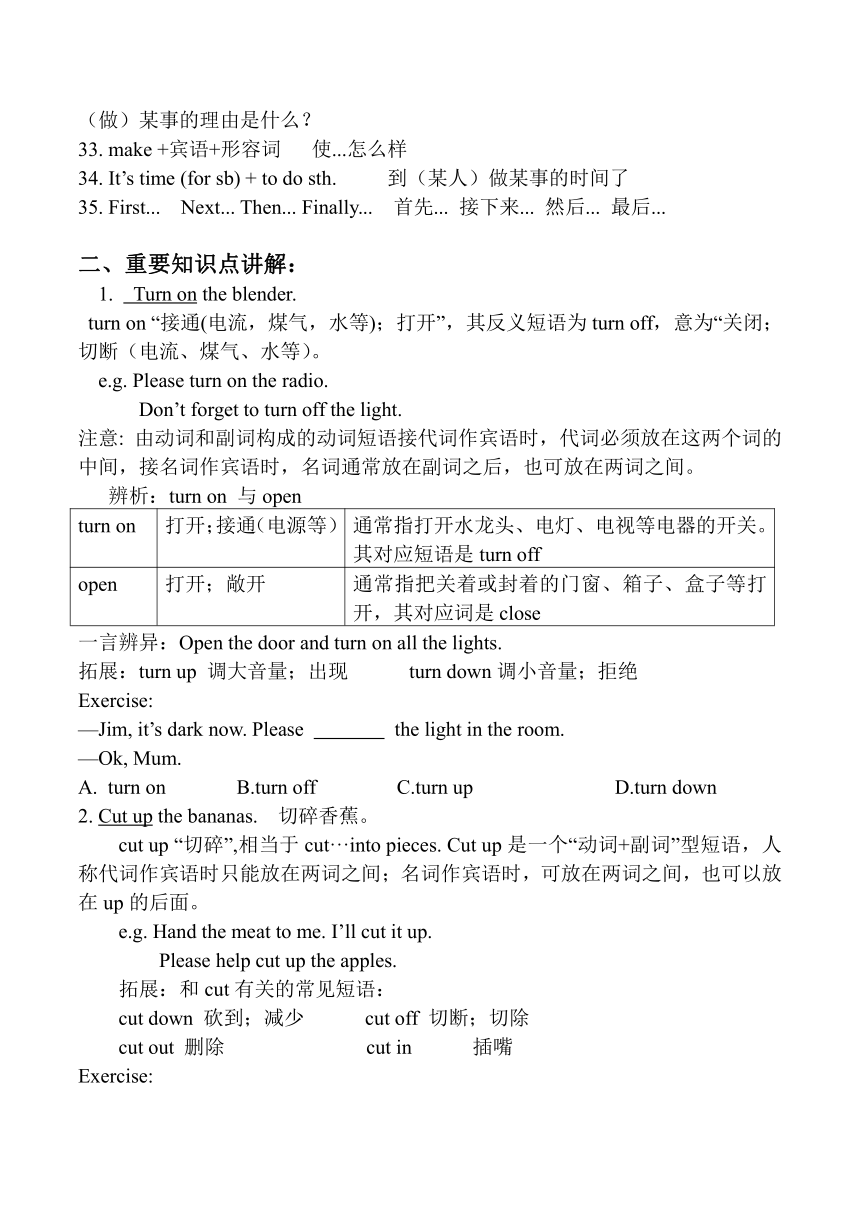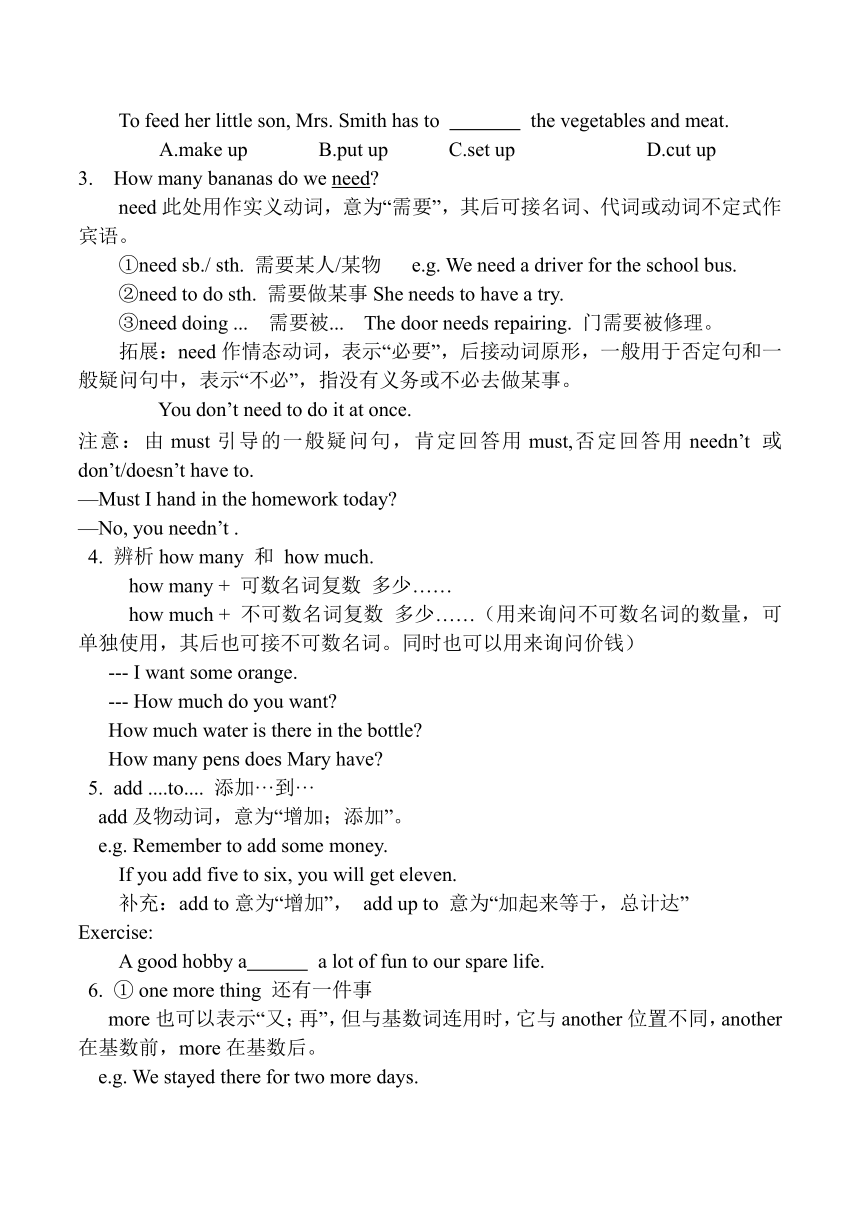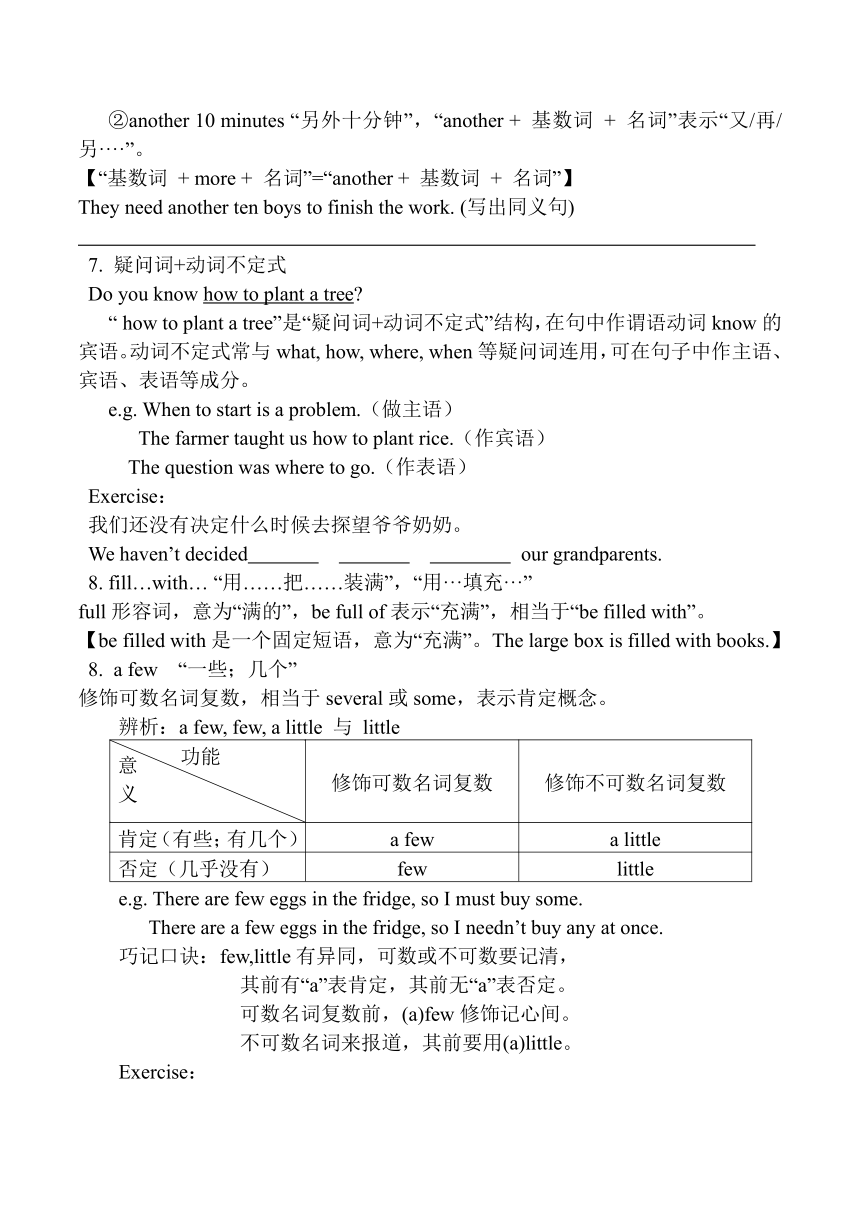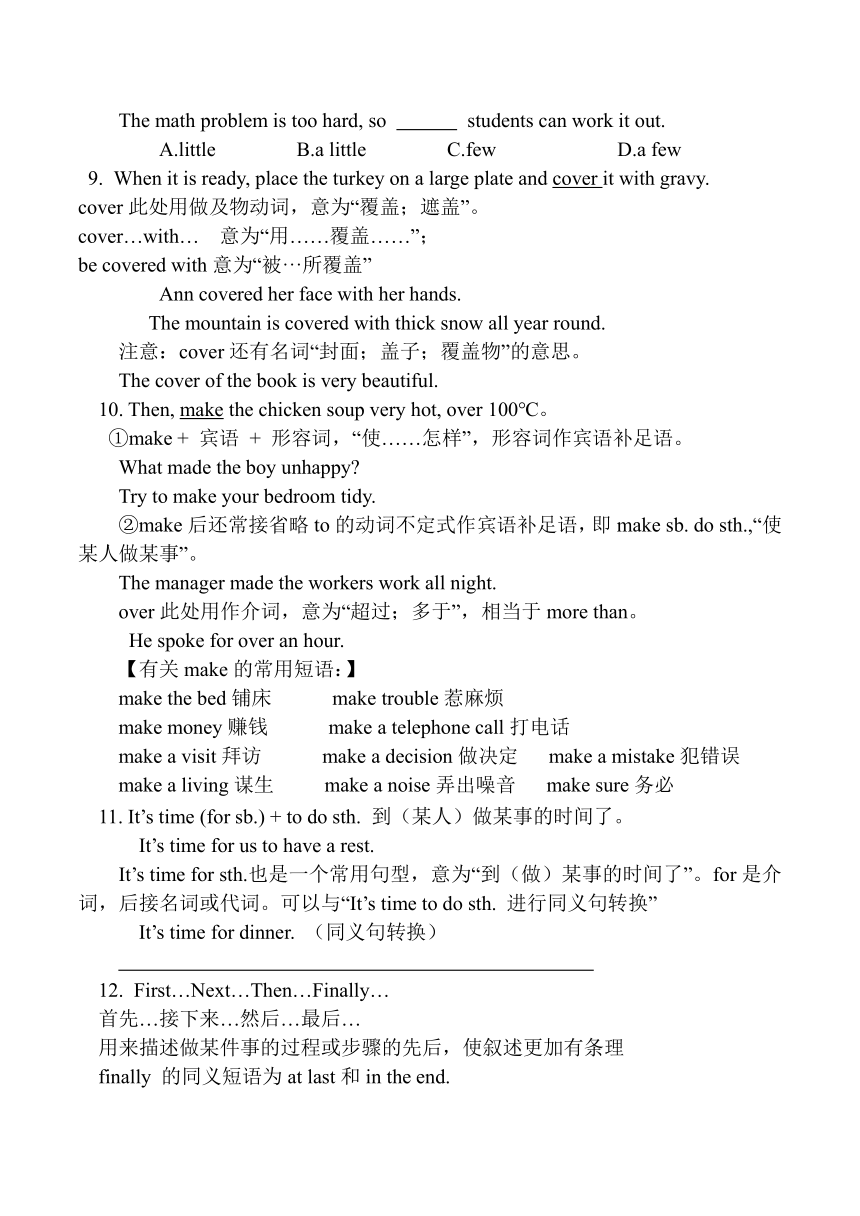人教八年级英语上册Unit 8 How do you make a banana milk shake? 知识点
文档属性
| 名称 | 人教八年级英语上册Unit 8 How do you make a banana milk shake? 知识点 |  | |
| 格式 | zip | ||
| 文件大小 | 156.5KB | ||
| 资源类型 | 教案 | ||
| 版本资源 | 人教新目标(Go for it)版 | ||
| 科目 | 英语 | ||
| 更新时间 | 2020-12-16 16:11:11 | ||
图片预览





文档简介
unit8
How
do
you
make
a
banana
milk
shake
?知识点
课本基础知识梳理:
turn
on
打开(电器等)
cut
up
切碎
pour...into...
把...倒进...里
add…
to…
把…加到….里
put...in/into
把...放进...
take
out
...from...=take
...out
of...
从...中...拿出
give
thanks
for...
因...表示感谢
see...as...
把...看作
get
together
团聚
mix...and...
把...和...混合
fill...with...
用...装满...
cover...with...
用...覆盖
cut...into...
把...切成...
serve
sth.
to
sb.
=serve
sb.
(with)
sth.用某物招待某人
place/put
...
on
a
plate
把...放在盘子上
one
cup
of
yogurt
一杯酸奶
a
piece
of...
一片/块/张...
another
10
minutes
另外10分钟
one
more
thing
还有一件事
a
few
一些;几个
one
by
one
一个接一个
these
days
现在;如今
at
this
time
此时
at
a
very
high
temperature
在高温下
on
special
holidays
在特殊的节日里
How
many+可数名词复数
多少....
How
much
+不可数名词
多少...
let
sb.
do
sth.
让某人做某事
want
(sb.)to
do
sth.
想让(某人)做某事
need
to
do
sth.
需要做某事
how
to
do
sth.
如何做某事
What
are
the
reasons
for
(doing)
sth?
(做)某事的理由是什么?
make
+宾语+形容词
使...怎么样
It’s
time
(for
sb)
+
to
do
sth.
到(某人)做某事的时间了
First...
Next...
Then...
Finally...
首先...
接下来...
然后...
最后...
二、重要知识点讲解:
1.
Turn
on
the
blender.
turn
on
“接通(电流,煤气,水等);打开”,其反义短语为turn
off,意为“关闭;切断(电流、煤气、水等)。
e.g.
Please
turn
on
the
radio.
Don’t
forget
to
turn
off
the
light.
注意:
由动词和副词构成的动词短语接代词作宾语时,代词必须放在这两个词的中间,接名词作宾语时,名词通常放在副词之后,也可放在两词之间。
辨析:turn
on
与open
turn
on
打开;接通(电源等)
通常指打开水龙头、电灯、电视等电器的开关。其对应短语是turn
off
open
打开;敞开
通常指把关着或封着的门窗、箱子、盒子等打开,其对应词是close
一言辨异:Open
the
door
and
turn
on
all
the
lights.
拓展:turn
up
调大音量;出现
turn
down调小音量;拒绝
Exercise:
—Jim,
it’s
dark
now.
Please
the
light
in
the
room.
—Ok,
Mum.
turn
on
B.turn
off
C.turn
up
D.turn
down
2.
Cut
up
the
bananas.
切碎香蕉。
cut
up
“切碎”,相当于cut···into
pieces.
Cut
up是一个“动词+副词”型短语,人称代词作宾语时只能放在两词之间;名词作宾语时,可放在两词之间,也可以放在up的后面。
e.g.
Hand
the
meat
to
me.
I’ll
cut
it
up.
Please
help
cut
up
the
apples.
拓展:和cut有关的常见短语:
cut
down
砍到;减少
cut
off
切断;切除
cut
out
删除
cut
in
插嘴
Exercise:
To
feed
her
little
son,
Mrs.
Smith
has
to
the
vegetables
and
meat.
A.make
up
B.put
up
C.set
up
D.cut
up
3.
How
many
bananas
do
we
need?
need此处用作实义动词,意为“需要”,其后可接名词、代词或动词不定式作宾语。
①need
sb./
sth.
需要某人/某物
e.g.
We
need
a
driver
for
the
school
bus.
②need
to
do
sth.
需要做某事She
needs
to
have
a
try.
③need
doing
...
需要被...
The
door
needs
repairing.
门需要被修理。
拓展:need作情态动词,表示“必要”,后接动词原形,一般用于否定句和一般疑问句中,表示“不必”,指没有义务或不必去做某事。
You
don’t
need
to
do
it
at
once.
注意:由must引导的一般疑问句,肯定回答用must,否定回答用needn’t
或don’t/doesn’t
have
to.
—Must
I
hand
in
the
homework
today?
—No,
you
needn’t
.
辨析how
many
和
how
much.
how
many
+
可数名词复数
多少……
how
much
+
不可数名词复数
多少……(用来询问不可数名词的数量,可单独使用,其后也可接不可数名词。同时也可以用来询问价钱)
---
I
want
some
orange.
---
How
much
do
you
want?
How
much
water
is
there
in
the
bottle?
How
many
pens
does
Mary
have?
add
....to....
添加···到···
add及物动词,意为“增加;添加”。
e.g.
Remember
to
add
some
money.
If
you
add
five
to
six,
you
will
get
eleven.
补充:add
to意为“增加”,
add
up
to
意为“加起来等于,总计达”
Exercise:
A
good
hobby
a
a
lot
of
fun
to
our
spare
life.
①
one
more
thing
还有一件事
more也可以表示“又;再”,但与基数词连用时,它与another位置不同,another在基数前,more在基数后。
e.g.
We
stayed
there
for
two
more
days.
②another
10
minutes
“另外十分钟”,“another
+
基数词
+
名词”表示“又/再/另····”。
【“基数词
+
more
+
名词”=“another
+
基数词
+
名词”】
They
need
another
ten
boys
to
finish
the
work.
(写出同义句)
疑问词+动词不定式
Do
you
know
how
to
plant
a
tree?
“
how
to
plant
a
tree”是“疑问词+动词不定式”结构,在句中作谓语动词know的宾语。动词不定式常与what,
how,
where,
when等疑问词连用,可在句子中作主语、宾语、表语等成分。
e.g.
When
to
start
is
a
problem.(做主语)
The
farmer
taught
us
how
to
plant
rice.(作宾语)
The
question
was
where
to
go.(作表语)
Exercise:
我们还没有决定什么时候去探望爷爷奶奶。
We
haven’t
decided
our
grandparents.
8.
fill…with…
“用……把……装满”,“用···填充···”
full形容词,意为“满的”,be
full
of表示“充满”,相当于“be
filled
with”。
【be
filled
with是一个固定短语,意为“充满”。The
large
box
is
filled
with
books.】
a
few
“一些;几个”
修饰可数名词复数,相当于several或some,表示肯定概念。
辨析:a
few,
few,
a
little
与
little
意义功能
修饰可数名词复数
修饰不可数名词复数
肯定(有些;有几个)
a
few
a
little
否定(几乎没有)
few
little
e.g.
There
are
few
eggs
in
the
fridge,
so
I
must
buy
some.
There
are
a
few
eggs
in
the
fridge,
so
I
needn’t
buy
any
at
once.
巧记口诀:few,little有异同,可数或不可数要记清,
其前有“a”表肯定,其前无“a”表否定。
可数名词复数前,(a)few修饰记心间。
不可数名词来报道,其前要用(a)little。
Exercise:
The
math
problem
is
too
hard,
so
students
can
work
it
out.
A.little
B.a
little
C.few
D.a
few
When
it
is
ready,
place
the
turkey
on
a
large
plate
and
cover
it
with
gravy.
cover此处用做及物动词,意为“覆盖;遮盖”。
cover…with…
意为“用……覆盖……”;
be
covered
with意为“被···所覆盖”
Ann
covered
her
face
with
her
hands.
The
mountain
is
covered
with
thick
snow
all
year
round.
注意:cover还有名词“封面;盖子;覆盖物”的意思。
The
cover
of
the
book
is
very
beautiful.
10.
Then,
make
the
chicken
soup
very
hot,
over
100℃。
①make
+
宾语
+
形容词,“使……怎样”,形容词作宾语补足语。
What
made
the
boy
unhappy?
Try
to
make
your
bedroom
tidy.
②make后还常接省略to的动词不定式作宾语补足语,即make
sb.
do
sth.,“使某人做某事”。
The
manager
made
the
workers
work
all
night.
over此处用作介词,意为“超过;多于”,相当于more
than。
He
spoke
for
over
an
hour.
【有关make的常用短语:】
make
the
bed铺床
make
trouble惹麻烦
make
money赚钱
make
a
telephone
call打电话
make
a
visit拜访
make
a
decision做决定
make
a
mistake犯错误
make
a
living谋生
make
a
noise弄出噪音
make
sure务必
11.
It’s
time
(for
sb.)
+
to
do
sth.
到(某人)做某事的时间了。
It’s
time
for
us
to
have
a
rest.
It’s
time
for
sth.也是一个常用句型,意为“到(做)某事的时间了”。for是介词,后接名词或代词。可以与“It’s
time
to
do
sth.
进行同义句转换”
It’s
time
for
dinner.
(同义句转换)
First…Next…Then…Finally…
首先…接下来…然后…最后…
用来描述做某件事的过程或步骤的先后,使叙述更加有条理
finally
的同义短语为at
last和in
the
end.
三:重要语法讲解:
祈使句
(1)定义:用于表达命令、请求、劝告、警告、禁止等的句子叫做祈使句,祈使句最常用于表达命令,因此在学校文法中也常称为命令句。
祈使句因对象(即主语)是第二人称(you),所以通常都省略。祈使句的动词都为动词原形。
Go
and
wash
your
hands.(去洗你的手。——命令)
Be
quiet,
please.(Please
be
quiet.)(请安静。——请求)
Be
kind
to
our
sister.(对姐妹要和善。——劝告)
Watch
your
steps.(走路小心。——警告)
Look
out!Danger!(小心!危险!——强烈警告,已如感叹句)
Keep
off
the
grass.(勿践草坪。——禁止)
No
parking.(禁止停车。——禁止)
祈使句的肯定形式:
类型
主要结构
例句
Do型
动词原形+(宾语)...
Add
some
water.
Be型
Be+表语...
Be
careful!
Let型
Let+宾语+动词原形...
Let
me
read
the
letter
for
you.
祈使句的否定形式:
类型
主要结构
例句
Don’t型
Don’t+动词原形+(其他)...
Don’t
go
out
at
night.
Never型
Never+动词原形+(其他)...
Never
be
late
again!
Let型
let前加Don’t
或在宾语后,动原前加not
Don’t
let
him
go.Let
us
not
talk
about
it.
No型
No+n/v.-ing
No
photos./
No
smoking.
可数名词与不可数名词
分辨可数名词和不可数名词
(1)可数名词有单数和复数两种形式,而不可数名词没有复数形式。
pen---pens
bread
(2)不定冠词、基数词可直接修饰可数名词,表示数量;而不可数名词在表示数量时则用“不定冠词/基数词
+
计量单位名词
+
of
+
不可数名词”。
an
apple,
a
piece
of
bread,
two
photos,
four
cups
of
water
(3)可数名词复数前可用many,
some,
any,
few,
a
few等修饰;
不可数名词前可用much,
some,
any,
little,
a
little等修饰。
many
teachers,
much
money,
some
books,
some
juice
(4)提问可数名词的数量用how
many,提问不可数名词的数量用how
much.
How
many
books
do
you
want?
How
much
salt
do
we
need?
(5)可数名词作主语时,谓语动词要与主语的单复数保持一致;不可数名词作主语时,谓语动词用单数。
Bananas
are
necessary
for
banana
milk
shake.
Money
is
important,
but
it
is
not
everything.
注意:若不可数名词前有表示计量单位的名词,则谓语动词要与表示计量单位的名词的单复数一致。
可数名词的复数形式。
可数名词复数的变化规则分为规则变化和不规则变化两种。
(1)规则变化
名词复数的构成,通常是在单数形式后加-s或-es,其方法如下:
情况
构成方法
读音
例词
一般情况
加-s
在清辅音后读/
s
/,在浊辅音和元音后读/
z
/,
在t后读/
ts
/,
在d后读/
dz
/
book--booksdog---dogsstudent---studentshand---hands
以s,
x,
sh,
ch等结尾的大多数词
加-es
读/
iz
/
class--classeswatch---watchesbox---boxes
以辅音字母加y结尾的词
变y为i,再加-es
读/
z
/
city---citiesbaby---babiesfactory---factories
以f(e)结尾的词
变f(e)为v,再加-es
读/
vz
/
wife---wiveshalf---halvesleaf---leaves
以字母o结尾的词
有生命的加-es
tomato---tomatoespotato---potatoeshero---heroes
无生命的加-s
radio---radiosphoto---photoszoo-zoos
(2)不规则变化
①改变单数名词中的元音字母。man---men,
tooth---teeth
②词尾有变化。child---children,
mouse---mice
③单复数同形。sheep---sheep,
deer---deer,
Chinese---Chinese
通常情况下,当一个名词作定语修饰另一个名词时,其复数形式只需将其主体词变为复数形式。但man或woman修饰另一个名词时,变复数时要将名词及man和woman都变成复数。
girl
student---
girl
students
new-comer----
new-comers
a
man
driver---
men
drivers
a
woman
teacher---
women
teachers
练习.
名词单数变复数填空
computer
lesson
banana
shirt
month
cup
parent
piano
photo
radio
tomato
potato
hero
class
fox
watch
glass
dress
brush
shelf
knife
wife
life
leaf
thief
wolf
family
country
story
butterfly
toy
day
key
sheep
fish
deer
Chinese
child
man
woman
foot
goose
tooth
mouse
Exercise:
I.
单项选择。
1.
_________
lady
in
red
over
there
is
ill
in
_________
hospital.
A.
The;
the
B.
A;
/
C.
The;
/
D.
A;
the
2.
The
Greens
_________
to
France
next
weekend.
A.
is
flying
B.
flies
C.
fly
D.
are
flying
3.
_________
Dangshen
is
good
for
your
health.
A.
To
eating
B.
Eating
C.
Eatting
D.
For
eating
4.
Who
can
_________
the
baby
_________?
A.
to
make;
stop
to
cry
B.
make;
to
stop
crying
C.
to
make;
stop
crying
D.
make;
stop
crying
5.
In
our
school,
there
are
more
than
one
hundred
_________
and
over
one
thousand
_________.
A.
woman
teachers;
girl
students
B.
women
teachers;
girl
students
C.
women
teachers;
girls
students
D.
woman
teachers;
girls
students
6.
–What
can
I
do
for
you?
--Please
___________
two
apples
and
then
_________.
A.
peel;
cut
them
up
B.
peel;
cut
up
them
C.
get;
cut
them
D.
get;
cut
them
down
7.
We’re
thirsty.
Please
give
us
_________.
A.
one
slice
of
bread
B.
two
cup
of
milk
C.
three
cups
of
water
D.
four
slice
of
bread
8.
–Would
you
like
some
_________?
---Oh,
yes.
Just
a
little.
A.
bananas
B.
bread
C.
apples
D.
tomatoes
9.
Pour
the
milk
__________
the
blender.
A.
in
B.
into
C.
on
D.
at
10.
Everything
for
our
new
house
is
bought,
so
we
_________
anything.
A.
need
to
not
buy
B.
don’t
need
buy
C.
needn’t
buy
D.
not
need
to
buy
11
There’s
__________
chicken
in
the
fridge.
Go
and
buy
some.
A.
a
little
B.
little
C.
few
D.
a
few
II.
用所给词的适当形式填空。
How
many
__________(run)
are
there
in
a
relay
race(接力赛)?
Could
you
cut
the
pear
into
two
__________(half)?
Two
_________(hour)
ride
is
not
so
long.
Happy
_________(child)
Day!
There
are
some
__________(sandwich)
on
the
table.
What
do
you
need
_________(buy)
for
supper?
III.
句型转换
I
need
one
apple.(改为一般疑问句)
you
one
apple?
They
need
yogurt.
(改为否定句)
They
yogurt.
Drink
the
milk
shake.
(以he为主语改写句子)
the
milk
shake
every
day.
Tom
had
two
eggs
and
a
piece
of
bread
for
lunch.
(对划线部分提问)
Tom
for
lunch?
We
need
one
spoon
of
honey.
(对划线部分提问)
How
do
you
need?
How
do
you
make
a
banana
milk
shake
?知识点
课本基础知识梳理:
turn
on
打开(电器等)
cut
up
切碎
pour...into...
把...倒进...里
add…
to…
把…加到….里
put...in/into
把...放进...
take
out
...from...=take
...out
of...
从...中...拿出
give
thanks
for...
因...表示感谢
see...as...
把...看作
get
together
团聚
mix...and...
把...和...混合
fill...with...
用...装满...
cover...with...
用...覆盖
cut...into...
把...切成...
serve
sth.
to
sb.
=serve
sb.
(with)
sth.用某物招待某人
place/put
...
on
a
plate
把...放在盘子上
one
cup
of
yogurt
一杯酸奶
a
piece
of...
一片/块/张...
another
10
minutes
另外10分钟
one
more
thing
还有一件事
a
few
一些;几个
one
by
one
一个接一个
these
days
现在;如今
at
this
time
此时
at
a
very
high
temperature
在高温下
on
special
holidays
在特殊的节日里
How
many+可数名词复数
多少....
How
much
+不可数名词
多少...
let
sb.
do
sth.
让某人做某事
want
(sb.)to
do
sth.
想让(某人)做某事
need
to
do
sth.
需要做某事
how
to
do
sth.
如何做某事
What
are
the
reasons
for
(doing)
sth?
(做)某事的理由是什么?
make
+宾语+形容词
使...怎么样
It’s
time
(for
sb)
+
to
do
sth.
到(某人)做某事的时间了
First...
Next...
Then...
Finally...
首先...
接下来...
然后...
最后...
二、重要知识点讲解:
1.
Turn
on
the
blender.
turn
on
“接通(电流,煤气,水等);打开”,其反义短语为turn
off,意为“关闭;切断(电流、煤气、水等)。
e.g.
Please
turn
on
the
radio.
Don’t
forget
to
turn
off
the
light.
注意:
由动词和副词构成的动词短语接代词作宾语时,代词必须放在这两个词的中间,接名词作宾语时,名词通常放在副词之后,也可放在两词之间。
辨析:turn
on
与open
turn
on
打开;接通(电源等)
通常指打开水龙头、电灯、电视等电器的开关。其对应短语是turn
off
open
打开;敞开
通常指把关着或封着的门窗、箱子、盒子等打开,其对应词是close
一言辨异:Open
the
door
and
turn
on
all
the
lights.
拓展:turn
up
调大音量;出现
turn
down调小音量;拒绝
Exercise:
—Jim,
it’s
dark
now.
Please
the
light
in
the
room.
—Ok,
Mum.
turn
on
B.turn
off
C.turn
up
D.turn
down
2.
Cut
up
the
bananas.
切碎香蕉。
cut
up
“切碎”,相当于cut···into
pieces.
Cut
up是一个“动词+副词”型短语,人称代词作宾语时只能放在两词之间;名词作宾语时,可放在两词之间,也可以放在up的后面。
e.g.
Hand
the
meat
to
me.
I’ll
cut
it
up.
Please
help
cut
up
the
apples.
拓展:和cut有关的常见短语:
cut
down
砍到;减少
cut
off
切断;切除
cut
out
删除
cut
in
插嘴
Exercise:
To
feed
her
little
son,
Mrs.
Smith
has
to
the
vegetables
and
meat.
A.make
up
B.put
up
C.set
up
D.cut
up
3.
How
many
bananas
do
we
need?
need此处用作实义动词,意为“需要”,其后可接名词、代词或动词不定式作宾语。
①need
sb./
sth.
需要某人/某物
e.g.
We
need
a
driver
for
the
school
bus.
②need
to
do
sth.
需要做某事She
needs
to
have
a
try.
③need
doing
...
需要被...
The
door
needs
repairing.
门需要被修理。
拓展:need作情态动词,表示“必要”,后接动词原形,一般用于否定句和一般疑问句中,表示“不必”,指没有义务或不必去做某事。
You
don’t
need
to
do
it
at
once.
注意:由must引导的一般疑问句,肯定回答用must,否定回答用needn’t
或don’t/doesn’t
have
to.
—Must
I
hand
in
the
homework
today?
—No,
you
needn’t
.
辨析how
many
和
how
much.
how
many
+
可数名词复数
多少……
how
much
+
不可数名词复数
多少……(用来询问不可数名词的数量,可单独使用,其后也可接不可数名词。同时也可以用来询问价钱)
---
I
want
some
orange.
---
How
much
do
you
want?
How
much
water
is
there
in
the
bottle?
How
many
pens
does
Mary
have?
add
....to....
添加···到···
add及物动词,意为“增加;添加”。
e.g.
Remember
to
add
some
money.
If
you
add
five
to
six,
you
will
get
eleven.
补充:add
to意为“增加”,
add
up
to
意为“加起来等于,总计达”
Exercise:
A
good
hobby
a
a
lot
of
fun
to
our
spare
life.
①
one
more
thing
还有一件事
more也可以表示“又;再”,但与基数词连用时,它与another位置不同,another在基数前,more在基数后。
e.g.
We
stayed
there
for
two
more
days.
②another
10
minutes
“另外十分钟”,“another
+
基数词
+
名词”表示“又/再/另····”。
【“基数词
+
more
+
名词”=“another
+
基数词
+
名词”】
They
need
another
ten
boys
to
finish
the
work.
(写出同义句)
疑问词+动词不定式
Do
you
know
how
to
plant
a
tree?
“
how
to
plant
a
tree”是“疑问词+动词不定式”结构,在句中作谓语动词know的宾语。动词不定式常与what,
how,
where,
when等疑问词连用,可在句子中作主语、宾语、表语等成分。
e.g.
When
to
start
is
a
problem.(做主语)
The
farmer
taught
us
how
to
plant
rice.(作宾语)
The
question
was
where
to
go.(作表语)
Exercise:
我们还没有决定什么时候去探望爷爷奶奶。
We
haven’t
decided
our
grandparents.
8.
fill…with…
“用……把……装满”,“用···填充···”
full形容词,意为“满的”,be
full
of表示“充满”,相当于“be
filled
with”。
【be
filled
with是一个固定短语,意为“充满”。The
large
box
is
filled
with
books.】
a
few
“一些;几个”
修饰可数名词复数,相当于several或some,表示肯定概念。
辨析:a
few,
few,
a
little
与
little
意义功能
修饰可数名词复数
修饰不可数名词复数
肯定(有些;有几个)
a
few
a
little
否定(几乎没有)
few
little
e.g.
There
are
few
eggs
in
the
fridge,
so
I
must
buy
some.
There
are
a
few
eggs
in
the
fridge,
so
I
needn’t
buy
any
at
once.
巧记口诀:few,little有异同,可数或不可数要记清,
其前有“a”表肯定,其前无“a”表否定。
可数名词复数前,(a)few修饰记心间。
不可数名词来报道,其前要用(a)little。
Exercise:
The
math
problem
is
too
hard,
so
students
can
work
it
out.
A.little
B.a
little
C.few
D.a
few
When
it
is
ready,
place
the
turkey
on
a
large
plate
and
cover
it
with
gravy.
cover此处用做及物动词,意为“覆盖;遮盖”。
cover…with…
意为“用……覆盖……”;
be
covered
with意为“被···所覆盖”
Ann
covered
her
face
with
her
hands.
The
mountain
is
covered
with
thick
snow
all
year
round.
注意:cover还有名词“封面;盖子;覆盖物”的意思。
The
cover
of
the
book
is
very
beautiful.
10.
Then,
make
the
chicken
soup
very
hot,
over
100℃。
①make
+
宾语
+
形容词,“使……怎样”,形容词作宾语补足语。
What
made
the
boy
unhappy?
Try
to
make
your
bedroom
tidy.
②make后还常接省略to的动词不定式作宾语补足语,即make
sb.
do
sth.,“使某人做某事”。
The
manager
made
the
workers
work
all
night.
over此处用作介词,意为“超过;多于”,相当于more
than。
He
spoke
for
over
an
hour.
【有关make的常用短语:】
make
the
bed铺床
make
trouble惹麻烦
make
money赚钱
make
a
telephone
call打电话
make
a
visit拜访
make
a
decision做决定
make
a
mistake犯错误
make
a
living谋生
make
a
noise弄出噪音
make
sure务必
11.
It’s
time
(for
sb.)
+
to
do
sth.
到(某人)做某事的时间了。
It’s
time
for
us
to
have
a
rest.
It’s
time
for
sth.也是一个常用句型,意为“到(做)某事的时间了”。for是介词,后接名词或代词。可以与“It’s
time
to
do
sth.
进行同义句转换”
It’s
time
for
dinner.
(同义句转换)
First…Next…Then…Finally…
首先…接下来…然后…最后…
用来描述做某件事的过程或步骤的先后,使叙述更加有条理
finally
的同义短语为at
last和in
the
end.
三:重要语法讲解:
祈使句
(1)定义:用于表达命令、请求、劝告、警告、禁止等的句子叫做祈使句,祈使句最常用于表达命令,因此在学校文法中也常称为命令句。
祈使句因对象(即主语)是第二人称(you),所以通常都省略。祈使句的动词都为动词原形。
Go
and
wash
your
hands.(去洗你的手。——命令)
Be
quiet,
please.(Please
be
quiet.)(请安静。——请求)
Be
kind
to
our
sister.(对姐妹要和善。——劝告)
Watch
your
steps.(走路小心。——警告)
Look
out!Danger!(小心!危险!——强烈警告,已如感叹句)
Keep
off
the
grass.(勿践草坪。——禁止)
No
parking.(禁止停车。——禁止)
祈使句的肯定形式:
类型
主要结构
例句
Do型
动词原形+(宾语)...
Add
some
water.
Be型
Be+表语...
Be
careful!
Let型
Let+宾语+动词原形...
Let
me
read
the
letter
for
you.
祈使句的否定形式:
类型
主要结构
例句
Don’t型
Don’t+动词原形+(其他)...
Don’t
go
out
at
night.
Never型
Never+动词原形+(其他)...
Never
be
late
again!
Let型
let前加Don’t
或在宾语后,动原前加not
Don’t
let
him
go.Let
us
not
talk
about
it.
No型
No+n/v.-ing
No
photos./
No
smoking.
可数名词与不可数名词
分辨可数名词和不可数名词
(1)可数名词有单数和复数两种形式,而不可数名词没有复数形式。
pen---pens
bread
(2)不定冠词、基数词可直接修饰可数名词,表示数量;而不可数名词在表示数量时则用“不定冠词/基数词
+
计量单位名词
+
of
+
不可数名词”。
an
apple,
a
piece
of
bread,
two
photos,
four
cups
of
water
(3)可数名词复数前可用many,
some,
any,
few,
a
few等修饰;
不可数名词前可用much,
some,
any,
little,
a
little等修饰。
many
teachers,
much
money,
some
books,
some
juice
(4)提问可数名词的数量用how
many,提问不可数名词的数量用how
much.
How
many
books
do
you
want?
How
much
salt
do
we
need?
(5)可数名词作主语时,谓语动词要与主语的单复数保持一致;不可数名词作主语时,谓语动词用单数。
Bananas
are
necessary
for
banana
milk
shake.
Money
is
important,
but
it
is
not
everything.
注意:若不可数名词前有表示计量单位的名词,则谓语动词要与表示计量单位的名词的单复数一致。
可数名词的复数形式。
可数名词复数的变化规则分为规则变化和不规则变化两种。
(1)规则变化
名词复数的构成,通常是在单数形式后加-s或-es,其方法如下:
情况
构成方法
读音
例词
一般情况
加-s
在清辅音后读/
s
/,在浊辅音和元音后读/
z
/,
在t后读/
ts
/,
在d后读/
dz
/
book--booksdog---dogsstudent---studentshand---hands
以s,
x,
sh,
ch等结尾的大多数词
加-es
读/
iz
/
class--classeswatch---watchesbox---boxes
以辅音字母加y结尾的词
变y为i,再加-es
读/
z
/
city---citiesbaby---babiesfactory---factories
以f(e)结尾的词
变f(e)为v,再加-es
读/
vz
/
wife---wiveshalf---halvesleaf---leaves
以字母o结尾的词
有生命的加-es
tomato---tomatoespotato---potatoeshero---heroes
无生命的加-s
radio---radiosphoto---photoszoo-zoos
(2)不规则变化
①改变单数名词中的元音字母。man---men,
tooth---teeth
②词尾有变化。child---children,
mouse---mice
③单复数同形。sheep---sheep,
deer---deer,
Chinese---Chinese
通常情况下,当一个名词作定语修饰另一个名词时,其复数形式只需将其主体词变为复数形式。但man或woman修饰另一个名词时,变复数时要将名词及man和woman都变成复数。
girl
student---
girl
students
new-comer----
new-comers
a
man
driver---
men
drivers
a
woman
teacher---
women
teachers
练习.
名词单数变复数填空
computer
lesson
banana
shirt
month
cup
parent
piano
photo
radio
tomato
potato
hero
class
fox
watch
glass
dress
brush
shelf
knife
wife
life
leaf
thief
wolf
family
country
story
butterfly
toy
day
key
sheep
fish
deer
Chinese
child
man
woman
foot
goose
tooth
mouse
Exercise:
I.
单项选择。
1.
_________
lady
in
red
over
there
is
ill
in
_________
hospital.
A.
The;
the
B.
A;
/
C.
The;
/
D.
A;
the
2.
The
Greens
_________
to
France
next
weekend.
A.
is
flying
B.
flies
C.
fly
D.
are
flying
3.
_________
Dangshen
is
good
for
your
health.
A.
To
eating
B.
Eating
C.
Eatting
D.
For
eating
4.
Who
can
_________
the
baby
_________?
A.
to
make;
stop
to
cry
B.
make;
to
stop
crying
C.
to
make;
stop
crying
D.
make;
stop
crying
5.
In
our
school,
there
are
more
than
one
hundred
_________
and
over
one
thousand
_________.
A.
woman
teachers;
girl
students
B.
women
teachers;
girl
students
C.
women
teachers;
girls
students
D.
woman
teachers;
girls
students
6.
–What
can
I
do
for
you?
--Please
___________
two
apples
and
then
_________.
A.
peel;
cut
them
up
B.
peel;
cut
up
them
C.
get;
cut
them
D.
get;
cut
them
down
7.
We’re
thirsty.
Please
give
us
_________.
A.
one
slice
of
bread
B.
two
cup
of
milk
C.
three
cups
of
water
D.
four
slice
of
bread
8.
–Would
you
like
some
_________?
---Oh,
yes.
Just
a
little.
A.
bananas
B.
bread
C.
apples
D.
tomatoes
9.
Pour
the
milk
__________
the
blender.
A.
in
B.
into
C.
on
D.
at
10.
Everything
for
our
new
house
is
bought,
so
we
_________
anything.
A.
need
to
not
buy
B.
don’t
need
buy
C.
needn’t
buy
D.
not
need
to
buy
11
There’s
__________
chicken
in
the
fridge.
Go
and
buy
some.
A.
a
little
B.
little
C.
few
D.
a
few
II.
用所给词的适当形式填空。
How
many
__________(run)
are
there
in
a
relay
race(接力赛)?
Could
you
cut
the
pear
into
two
__________(half)?
Two
_________(hour)
ride
is
not
so
long.
Happy
_________(child)
Day!
There
are
some
__________(sandwich)
on
the
table.
What
do
you
need
_________(buy)
for
supper?
III.
句型转换
I
need
one
apple.(改为一般疑问句)
you
one
apple?
They
need
yogurt.
(改为否定句)
They
yogurt.
Drink
the
milk
shake.
(以he为主语改写句子)
the
milk
shake
every
day.
Tom
had
two
eggs
and
a
piece
of
bread
for
lunch.
(对划线部分提问)
Tom
for
lunch?
We
need
one
spoon
of
honey.
(对划线部分提问)
How
do
you
need?
同课章节目录
- Unit 1 Where did you go on vacation?
- Section A
- Section B
- Unit 2 How often do you exercise?
- Section A
- Section B
- Unit 3 I'm more outgoing than my sister.
- Section A
- Section B
- Unit 4 What's the best movie theater?
- Section A
- Section B
- Unit 5 Do you want to watch a game show?
- Section A
- Section B
- Unit 6 I'm going to study computer science.
- Section A
- Section B
- Unit 7 Will people have robots?
- Section A
- Section B
- Unit 8 How do you make a banana milk shake?
- Section A
- Section B
- Unit 9 Can you come to my party?
- Section A
- Section B
- Unit 10 If you go to the party, you'll have a grea
- Section A
- Section B
